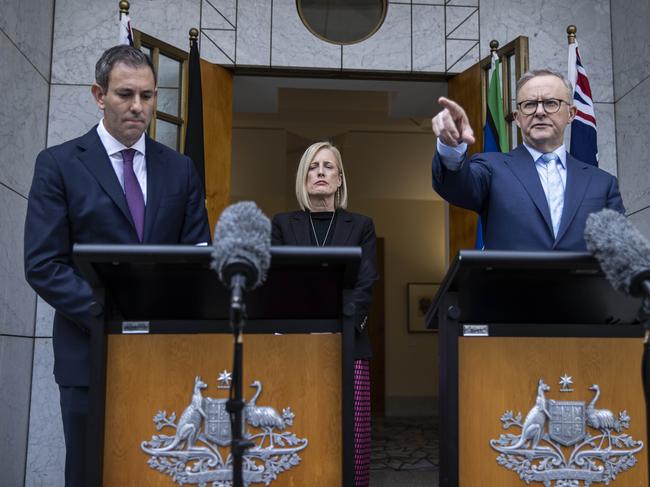Federal budget 2022: Tax cuts and what they mean for you
The federal government has confirmed tax cuts are coming, but first there is some pain in the way. See who will pay what and when.
Federal Budget
Don't miss out on the headlines from Federal Budget. Followed categories will be added to My News.
The federal government has stuck to its promise of following through with widespread income tax cuts from 2024 but low and middle income earners will take a hit in the interim as the Low and Middle Income Tax Offset (LMITO) comes to an end.
In its attempts to balance the pressures on its own finances with cost of living pressures, the government chose not to extend the temporary LMITO on Tuesday, bringing to an end another stimulus measure that has supported Australians during Covid-19.

Taxpayers earning up to $126,000 have been eligible for the tax offset, which was extended in the May 2021 budget, and then increased from $1080 to a maximum $1500 in the March 2022 pre-election budget. It was always scheduled to end in July 2022.
One-off support payments during the pandemic and the six-month fuel excise discount have also come to an end, and low and middle income earners are now bracing for a hit to their pay packets as they await future tax cuts due to come in from 2024.
Debate over the contentious stage three tax cuts, crafted by the former Morrison government, has escalated in the wake of Covid-19, which has put increasing pressure on government finances.
Critics, including welfare advocates, the Greens and some within Labor, have said the cuts are not equitable or affordable, particularly at a time when Australia is facing such precarious economic conditions.
But the federal government has consistently ruled out meddling with the cuts.
It means that from July 2024 Australians earning between $45,000 and $200,000 will pay no more than 30 cents in ever dollar they earn in tax, with the number of tax brackets being reduced from five to four.
The changes will cost the government $20bn a year, or $254bn over a decade, according to the latest Treasury costings.
Earlier this month Treasurer Jim Chalmers said there were “more pressing priorities in the interim” than making changes to tax cuts that had been legislated and budgeted.
On Tuesday night Dr Chalmers made no mention of the policy in his budget speech, leaving the tax cuts untouched and available to low and middle income earners from 2024.
But he said the government, through other measures, was focused on putting the budget “on a more sustainable path”.
“Tonight, we take the first step – with a budget repair package that delivers $28.5bn in improvements over the next four years,” Dr Chalmers said.
“This unwinds wasteful or unnecessary spending, redirects it towards higher-quality investments and priorities, and improves the integrity and fairness of our tax system.”
Dr Chalmers said $4.7bn in savings would be realised over four years by making multinationals “pay a fairer share of tax in Australia”, by extending tax compliance programs and by “giving the ATO the resources they need to crack down on tax dodging”.

The federal government has benefited from the country’s low unemployment rate, which has delivered higher income tax revenue into its coffers.
Personal income tax revenue is expected to account for 46 per cent of the government’s budgeted income in 2022-23.
However Dr Chalmers said on Tuesday the “temporary revenue boost” would fade, while “profound and permanent spending pressures on the budget are forecast to grow and grow”.
Governments around the world have been forced to rein in spending and abandon stimulus measures, including tax cuts, as they face soaring inflation and rising interest rates.
Former UK prime minister Liz Truss’s recent attempts to cut tax rates jittered global markets and ultimately cost her the top job despite her last ditch attempt to scrap the plan.
DEVIL IN THE DETAIL: WHY YOU’RE BEING DUDDED
This budget is more conservative and Liberal than any recent Liberal budget, with a devil in the detail that you don’t see.
Treasurer Jim Chalmers is doing part of the Reserve Bank’s work to tame inflation by stripping up to $1500 a year from millions of individuals in 2023.
While the budget papers do not show Australians losing any disposable income, that’s exactly what’s happening because the enlarged and extended Low and Middle Income Tax Offset (LMITO) – paid via tax refunds – is no more. The LMITO was extended in the May 2021 budget, then increased from $1080 to a maximum $1500 in March 2022, but it was always scheduled to end in July 2022.
If the government had chosen to extend the LMITO into the current financial year and beyond, it would need about $12bn more annually to pay for it, because everybody earning below $126,000 received a benefit.

The death of the LMITO is effectively a silent tax rise, because people will not notice the money missing until they receive smaller tax refunds from July 2023. It equates to $250 a month lost for dual-income households earning average wages – about five typical Reserve Bank interest rate rises.
However, childcare subsidy increases for many families with young children from July 2023 will offset their LMITO losses.
The budget’s other cost-of-living relief is more targeted – covering medicines, housing and paid parental leave – rather than the across-the-board cash splashes and handouts we saw in recent Coalition budgets.
From inside the lockup in Canberra, PwC chief economist Amy Auster described the budget as “economically healthy”.
“It’s an eat-your-broccoli budget,” she said.
“I think it’s a strong budget that avoids the mistake that the UK made when it ignored reality and pushed against central bank moves to restrain inflation.
“At the end of the day, inflation is the worst form of an increase in the cost of living.” - Anthony Keane
More Coverage
Read related topics:Cost Of Living




